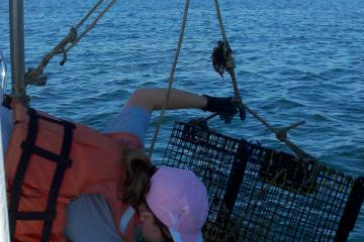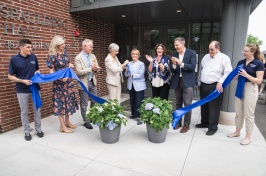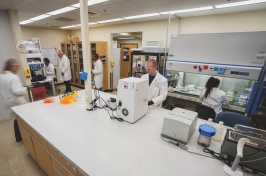UNH Research Finds Ventless Lobster Trap Effective in Monitoring Populations

Abigail Clark ('12), lead study author, checking a lobster trap at study site, Wallis Sands State Beach, Rye, N.H. photo credit: Christopher Chambers '12
DURHAM, N.H. — New research from the University of New Hampshire is shedding light on "ventless" lobster traps, indicating that they help scientists learn more about lobster populations in the Gulf of Maine than standard lobster traps.
Research recently published in the journal Fisheries Research looked at the efficacy of using ventless traps — those with blocked escape vents — to help biologists improve their understanding of lobster populations, the size range of lobsters on the bottom and how long it takes for a trap to saturate, or reach its maximum capacity of lobsters. These data are crucial for use in computer models that forecast lobster populations and aid in the development of management decisions to ensure thriving stocks in the future.
A lobster's primary escape route from a trap is the vent found in standard lobster traps used by commercial lobstermen. They are designed to let the smaller, sub-legal-sized lobsters exit so they can go on to grow and reproduce in future years. However, for research purposes, this renders the population estimates and size structure data less accurate. Therefore, starting in the mid-2000s, biologists in New England began using ventless trap surveys to capture juvenile lobsters in hopes of improved estimates on that segment of the population.
Lobsters typically congregate in rocky areas making it difficult for trawl fishing nets to sample, so researchers decided to focus their data collection efforts in the sandy waters just off of Wallis Sands State Beach in Rye, placing standard and ventless traps near each other, and using SCUBA surveys to count the number of lobsters on the bottom nearby.
"You might not think there are a lot of lobsters there because it's open sand, but there are in the summer," said Win Watson, professor of zoology in the department of biological sciences, andco-author of the study. The sandy bottom allows researchers to see more lobsters than in a rocky habitat and thus more easily compare what they saw on the open sand to what they caught in the traps.
While researchers found evidence that ventless traps are better predictors than standard traps for how many lobsters are actually out there, they do not provide a very accurate indication of the sizes of lobsters that exist in the wild, Watson explained. Tiny lobsters don't usually enter the traps to search for food because the juveniles are filter feeders, so part of the size structure of the population is not accurately captured in these surveys.
"We can catch 10 times more lobsters per trip with ventless traps, so we're seeing more of what's down there and we're getting a better idea of the size structure, but we're still not getting the whole picture," Watson added.
"The value of conducting this study was to determine if ventless traps do, in fact, provide a better representation of lobster abundance and size distribution than standard traps," said
Abigail Clark '12, lead author for the study. "In so doing, we were able to calibrate the surveys currently used to inform management practices."
Results from this study offer definitive, third-party evidence that biologists throughout New England are using the best available science to study lobster populations, added Watson.
In addition, the results show that traps saturate somewhere between 16-24 hours — a shorter period of time than previously suspected, meaning that traps can be pulled after a day of deployment and still provide accurate data.
"This information on the time to trap saturation will improve surveys by shortening soak periods and potentially reducing effort for biologists performing the surveys," Clark said. Watson is currently conducting additional studies to determine the cause of trap saturation.
The peer-reviewed journal article based on research funded by N.H. Sea Grant entitled, "A comparison of American lobster size structure and abundance using standard and ventless traps," can be found in the journal Fisheries Research.
N.H. Sea Grant informs the wise use, conservation and sustainable development of marine and coastal resources in the state, the region and beyond. Located at the University of New Hampshire, NHSG is part of a national network of programs located in our coastal and Great Lakes states as well as in Puerto Rico and Guam.
The University of New Hampshire, founded in 1866, is a world-class public research university with the feel of a New England liberal arts college. A land, sea, and space-grant university, UNH is the state's flagship public institution, enrolling 13,000 undergraduate and 2,500 graduate students.
Images to be downloaded:
/unhtoday/news/releases/2015/12/images/img-10Abigail.jpg
Abigail Clark ('12), lead study author, checking a lobster trap at study site, Wallis Sands State Beach, Rye, N.H.
photo credit: Christopher Chambers '12
/unhtoday/news/releases/2015/12/images/img-8Galen.jpg
UNH fishing vessel loaded with ventless and standard traps used in the research. The traps were provided by Robert Glenn and Tracy Pugh from the Massachusetts Division of Marine Fisheries.
Photo Credit: Abigail Clark '12
Latest News
-
June 25, 2025
-
June 16, 2025
-
June 6, 2025
-
May 15, 2025
-
May 14, 2025
















































